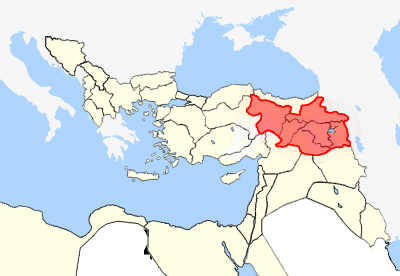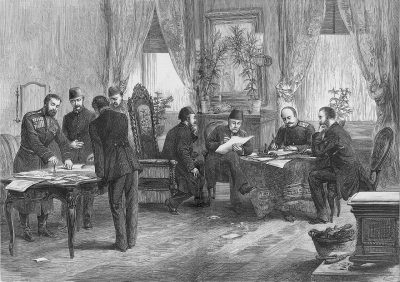
Western Armenia and the Six Provinces
(Vilâyat-ı Sitte)
The eastern parts of the Ottoman Empire – Anatolia, Armenia and Kurdistan – which were predominantly inhabited by non-Turks, were restructured administratively numerous times.
Under Sultan Murat III (1574-1596), the General Governorate Armenia (Eyalat Ermenistan) was the first to establish larger administrative units on the territory of the Ottoman-controlled Armenian settlement area (Western Armenia). This vast administrative unit was sub-divided into six pashalyks (Erzurum, Beyazıt, Kars, Van, Diyarbakır and Sivas). The boundaries of these pashalyks initially corresponded to the settlement areas of the respective majority populaces. Under Mahmut I, however, the number of Ottoman General Governorates was increased to 28 in 1834. Around the middle of the 19th century, Western Armenia was further sub-divided into the five provinces (vilayets) of Erzurum, Sivas, Trapezunt, Diyarbakir and Kharberd (Harput). Then, in 1864-66, the Eyalat of Ermenistan was eventually erased “by statesmen eager to destroy any potential base for national claims“.(1) Around the turn of the 19th century, three smaller General Governorates – Erzurum (with the entire northeast of Asia Minor), Kharberd and Kurdistan – existed in the Armenian Highland; the latter included the district of Van as Armenian settlement area.
Between 1868 and 1878 the western Armenian settlement areas were assigned to the three provinces Erzurum, Sivas and Diyarbakir, which at the same time contained numerous areas in which always only few Armenians had lived. Of these three provinces, the Vilayet Erzurum had the largest share of Turkish Armenia, including the cities of Kars, Erzurum, Van, Bitlis and Mush. After the cession of Kars to Russia (1878), the remaining Armenian districts of the Vilayet Erzurum were reorganized, creating the three new provinces of Sivas, Van and Bitlis. These, together with the provinces of Diyarbakir and Mamuret ül-Aziz, became known as the ‘Six (West Armenian) Provinces’ (Vilâyat-ı Sitte).

© By Yerevanci – Own work, CC BY-SA 3.0, https://commons.wikimedia.org/w/index.php?curid=16950583
The subsequent territorial divisions between 1864 and 1880 resulted in an interweaving of Armenian and Kurdish settlement areas. The following non-Armenian areas were incorporated into the western Armenian provinces: the south of the province Diyarbakır, the district Hakkari into the province Van, the south of the district Malatya in the province Kharberd (Harput; Mamüret-ul-Aziz), the south of the district Siirt into the province Bitlis as well as the west and northwest of the province Sivas. Compared to the Anatolian provinces with an average area of 100,000 square kilometers, the ‘Six Provinces’ only covered an average of 35,000 square kilometers after the reclassification, which allowed greater access by the Ottoman administration. The toponym ‘Armenia’, which had still been used in the Russian-Ottoman Preliminary Treaty of San Stefano (March 3, 1878), was deliberately abandoned after the Berlin Congress. From then on only ‘Kurdistan’ or ‘Anatolia’ was mentioned.
Already in 1914 Paul Rohrbach accurately characterized the political consequences of the administrative reorganization of West Armenia as politicized statistics in reaction to the Berlin Treaty of 1878:
“It is recalled that after the Berlin Congress, the entire administrative division in eastern Asian Turkey was changed in order to artificially create as large a number of non-Armenians as possible in each of the six so-called Vilayets. For this purpose, the provinces received large bulges and extensions into the Kurdish and Turkish linguistic areas and also interfered with each other with the strangest attachments and tongues. Then the actual number of Armenians was divided by two, and before Europe a provincial population statistic was presented which proved the sentence to be proven: ‘There would be no larger areas within Turkey in which the Armenians formed the majority or even approached only half the population’.”
Source: Rohrbach, Paul: Die Armenier als politischer und kultureller Faktor im Orient [The Armenians as a political and cultural factor in the Orient]. “Mesrop”, Zeitschrift der Deutsch-Armenischen Gesellschaft, 1. Jg., 1914, Juli-August, p. 1

